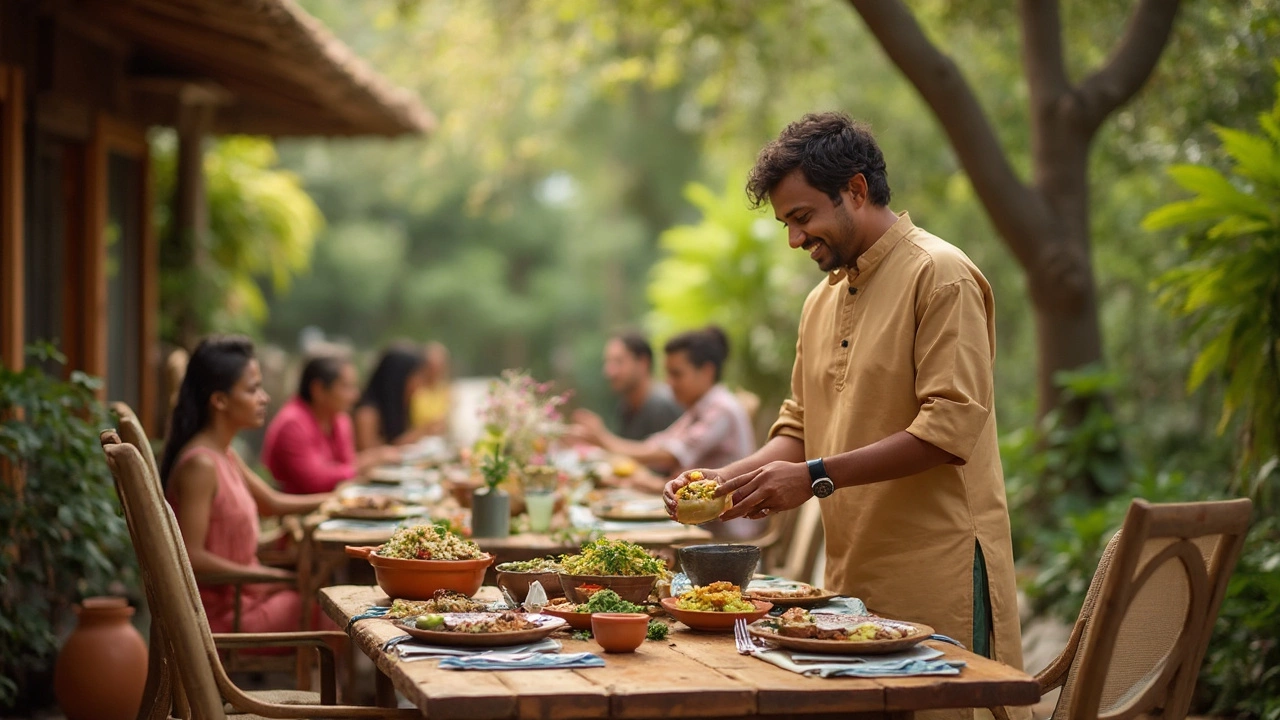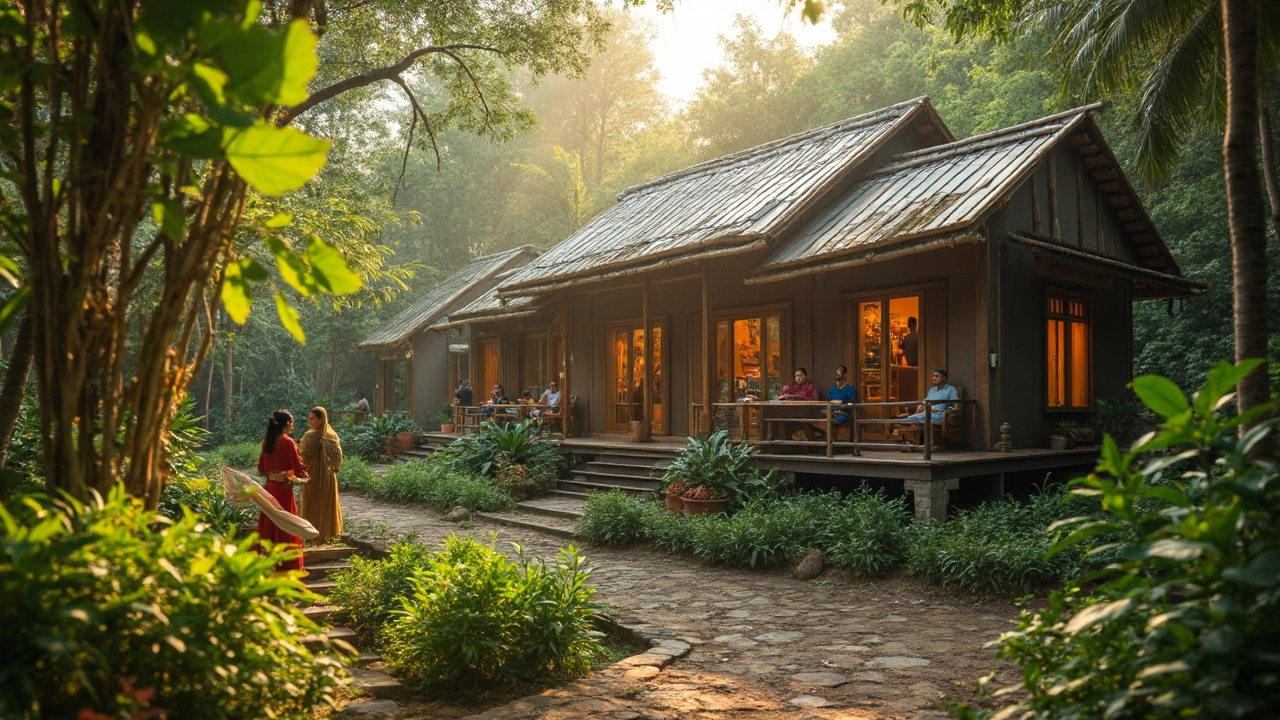Eco resorts are popping up everywhere, but there’s a big difference between a resort that just throws a couple of recycling bins outside and one that’s truly green from the ground up. If you care about reducing your vacation’s footprint—or maybe you’re even toying with the idea of running an eco resort—getting clear on what sets real eco resorts apart saves you from falling for greenwashing.
Start with the bones of the place: materials and design. Real eco resorts use smart building tricks and materials that don’t just look pretty but actually cut back on waste and pollution. Think recycled wood, locally sourced stone, and natural ventilation instead of blasting the AC. It’s not about sacrifice—it's about working with nature, not fighting against it.
- Eco-Friendly Materials and Design
- Water and Energy Conservation
- Local Food and Responsible Sourcing
- Community Engagement and Employment
- Balancing Comfort and Sustainability
Eco-Friendly Materials and Design
If you’re sizing up an eco resort, check out what it’s made of—literally. The right materials and smart design do a lot of the heavy lifting. The core idea? Use stuff that’s reused, upcycled, or taken right from the local environment with minimal impact. Why ship hardwood halfway around the world if there’s perfectly good bamboo nearby?
Eco resorts usually stick with a few tried-and-true materials:
- Bamboo: Grows fast, doesn’t need pesticides, perfect for everything from flooring to furniture.
- Reclaimed wood: Salvaged from old buildings so nothing goes to waste.
- Locally quarried stone: Means less fuel burned hauling materials long distances.
- Recycled metal: Used for everything from roofing to artistic details. Cuts down on mining and processing energy.
- Natural insulation: Stuff like sheep’s wool or cork keeps things comfy without plastics.
But the building itself also matters. Smart design reduces the need for heating, cooling, and lighting. Here’s what a well-designed eco resort usually pulls off:
- Lots of windows set just right for natural light and cross-breezes.
- Shade from trees or overhangs, so you don’t have to crank the AC.
- Green roofs or living walls to keep buildings cool and provide habitat for local wildlife.
- Modular building parts, so nothing gets tossed out if things need to be changed later.
Just how much of a difference does this make? Check out these real-life figures:
| Building Material | Average CO2 Emitted (kg/ton produced) |
|---|---|
| Steel | 1,850 |
| Concrete | 900 |
| Bamboo | 90 |
| Reclaimed wood | 30 |
So when resorts prioritize bamboo or reclaimed wood, they’re slashing carbon emissions compared to places that go the concrete and steel route. Plus, using local materials keeps cash and jobs in the local community rather than sending it overseas. All this isn’t just good for the planet—it’s actually smart business and a big reason eco resorts don’t just look different, they feel different too.
Water and Energy Conservation
Water and energy saving tricks are where eco resorts prove they’re not just for show. You’ll spot rainwater collection tanks, low-flow toilets, and smart irrigation everywhere if the place means business. Harvested rainwater isn’t just for gardens—some resorts reuse it for flushing toilets or even for laundry, quickly slashing daily water use. Installing water-saving fixtures can cut water usage by over 40%, which, trust me, adds up fast when guests are showering after hikes or pool dips.
With energy, the gold standard is renewable—think solar panels on rooftops and batteries that stash up power for cloudy days. Solar water heaters are pretty common now, especially in places where everyone wants a hot shower at the same time. Some resorts go all in and use wind turbines if the location gets regular breezes, or even invest in small-scale hydropower.
Great eco resorts don’t stop with the tech. They ask guests to play along, maybe by hanging up towels to use again or offering gentle reminders to switch off lights and fans when leaving rooms. Some even design rooms to catch ocean breezes instead of relying so much on AC—way more comfortable and a lot less power-hungry.
- High-efficiency LED lighting throughout the property
- Motion sensor lights in common areas
- Timers on pool pumps and hot tubs to avoid waste
- Solar charging stations for devices and even e-bikes
The mix of advanced tech and just plain common sense helps true eco resort spots shrink their environmental impact without making you feel like you’re camping out. It’s smart, practical, and it actually works—and I see my own kids getting excited when they realize places like this actually exist in real life.

Local Food and Responsible Sourcing
Great eco resorts don’t just look green—they taste it too. What’s on your plate matters almost as much as what’s outside your window. Sourcing food locally means fresher ingredients, way less food miles, and real support for area farmers. A lot of resorts now have kitchen gardens or work with farms within a 50-mile radius. You’ll see seasonal menus where the catch of the day is actually from that day, and the veggies came from a neighbor—not flown halfway across the world.
Local doesn’t stop with produce. Responsible eco resort kitchens think about the whole supply chain. That means buying seafood caught without harming reefs, working with ethical meat suppliers (or skipping meat altogether), and making sure things like coffee, tea, and chocolate are fair trade. The best places don’t serve endangered fish. They’ll even show you the source of their honey or the story behind a homemade cheese.
If you’re running an eco resort, here are a few ways to keep food sourcing honest and impactful:
- Partner with nearby farmers, fishers, and co-ops.
- Highlight these producers on your menus—it helps guests make good choices and gives the locals deserved credit.
- Grow some food onsite—even just a small herb garden makes a difference.
- Say no to single-use plastics and packaging when buying supplies.
- Compost food scraps if possible, or give leftovers to local livestock instead of sending them to landfill.
This approach isn’t just for show. A study from Cornell’s Sustainable Tourism program reported almost 70% of eco-minded travelers actively look for resorts that source food locally. People want to eat well and feel good about how their breakfast got to their table.
Community Engagement and Employment
If you ask locals in famous eco resort areas, they’ll tell you the best green resorts do a lot more than just save energy—they build real partnerships. A true eco resort works hand in hand with the local community, hiring local staff, using neighborhood suppliers, and even supporting schools or clinics. The goal: money spent by guests actually sticks around and makes a difference for people who live nearby.
Look at Soneva Fushi in the Maldives, where over 70% of staff come from local islands. Or check out Costa Rica’s Lapa Rios Lodge, which trains and hires guides from the same communities that surround the rainforest. This isn’t just about being nice—guests feel the experience is a lot more authentic, too.
- Job creation: Eco resorts often focus on hiring locals, not just at front desk, but for chefs, maintenance, guiding, and management roles.
- Training: Many green resorts offer job training in hospitality and conservation, which gives locals new skills they can use anywhere.
- Local business support: They source food, decorations, and supplies from nearby markets and farms, meaning money gets recycled at home instead of sent out of the country.
- Culture and education: Some organize tours, workshops, or performances by community members, sharing traditions with travelers and boosting local pride.
Here’s a quick look at community impacts from three well-known eco resort projects:
| Resort | Local Staff Percentage | Community Projects |
|---|---|---|
| Soneva Fushi (Maldives) | 70% | Funds local school programs, marine conservation training |
| Lapa Rios (Costa Rica) | 95% | Wildlife guide training, supports village recycling |
| Six Senses Laamu (Maldives) | 68% | Coral planting with islanders, supports health outreaches |
If you want to spot the real deal and not just the marketing fluff, ask about where the staff are from or if the resort works with local farms or social projects. Real eco resorts are open about these details—and proud of it. When done well, community engagement lifts up everyone: the people who live there, the resort, and even the travelers who get a more memorable, meaningful stay.

Balancing Comfort and Sustainability
This is the part most folks worry about—will being eco-friendly mean sacrificing comfort when you’re at an eco resort? Good news: the best places prove you really can have both. Modern guests want fluffy towels and Wi-Fi but also expect that their stay doesn’t wreck the planet. Getting this balance right is what sets a true eco resort apart.
Take energy use, for example. Instead of blasting air conditioners all day, some resorts use smart design: ceiling fans, shaded verandas, or green roofs that keep rooms cool naturally. Many now install solar panels or even use biogas from food waste to heat water, so you get that hot shower without the guilt. You probably won’t notice the difference other than in the bragging rights.
Water conservation is another big topic. Eco resorts often swap out regular showerheads and toilets for low-flow models. Some even collect rainwater to use for landscaping or laundry. You’ll still enjoy a good shower—just without the waste.
Don’t forget about food comfort. Lots of eco resorts serve farm-to-table meals using local, seasonal produce. The menus feel just as special, maybe even more so, since you’re tasting local flavors and supporting community farmers at the same time. If you have picky eaters like Finn, this can actually give you more choices since kitchens are drawing from nearby resources and can tweak menus on the fly.
And yes, there’s still Wi-Fi, comfy beds, and working toilets—just delivered in smarter, greener ways. The goal isn’t to make you ‘rough it’ but to show you that sustainability and comfort can actually work together without a hassle.
